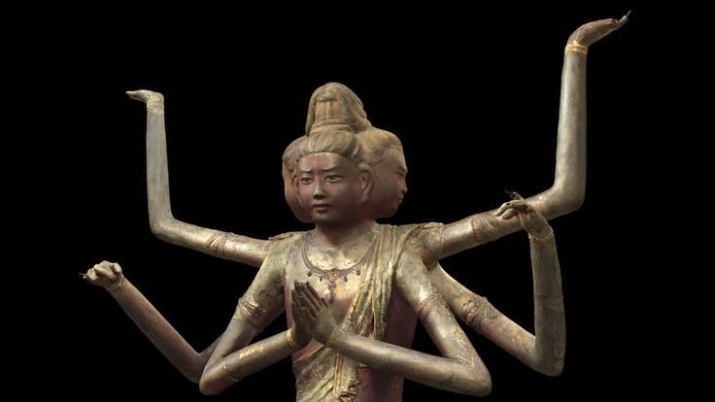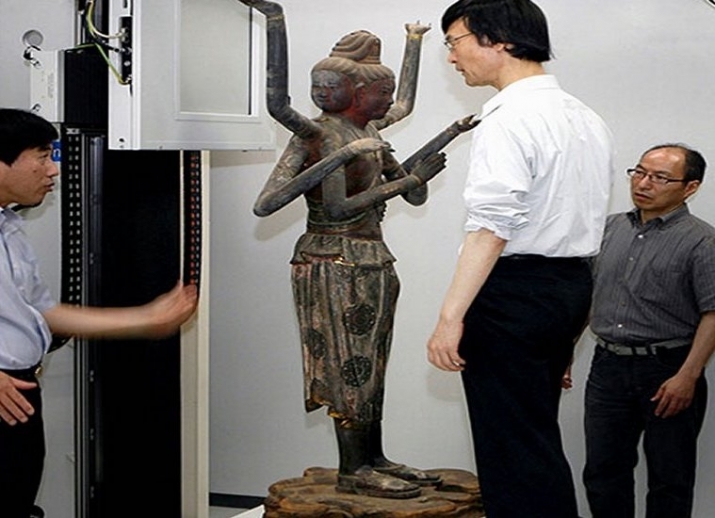NEWS
X-ray Scans Reveal Secrets of 1,300-year-old Buddhist Statue
 The statue of Ashura from Kofuku-ji in Nara. From pinterest.com
The statue of Ashura from Kofuku-ji in Nara. From pinterest.comAfter seven years of CT scans and in-depth investigation and analysis, one of the most famous works of Buddhist art in Japan, a three-faced, six-armed statue of Ashura, which has been dated to the 8th century, has revealed some of the secrets to its history and original appearance that have for years been the subject of debate among art historians.
The highly regarded artifact, a government-designated national treasure that has been dubbed “Japan’s Venus de Milo,” has been in the possession of Kofuku-ji, a temple in the historic city of Nara, for some 1,300 years. Over the course of the intervening centuries, the statue has survived wars, fires, and earthquakes, but not without damage, and the sacred sculpture has been restored and repaired on more than one occasion. After years of analyzing CT scans, a dedicated team of researchers has uncovered evidence of past repair work that they believe sheds light on the statue’s original pose.
The x-ray scans revealed that a compound of lacquer and wood dust had been used as a filler in the armpits of the two front-most arms as part of repairs carried our during Japan’s Meiji period (1868–1912) to rejoin the arms, resulting in the unnaturally raised positions of both elbows. Working with a reproduction of the statue, the team was able to determine that both arms would return to their original positions with the lacquer filler removed, bringing both arms closer to the body with the palms raised together, and shifting the left palm some 2 centimeters closer to the statue’s center.
Following extensive repair work from 1902–05, including the replacement of a portion of the sculpture’s right front-most arm, the two hands have been joined together slightly left of center, and some historians have speculated they once grasped a Buddhist object or implement.
 Researchers take CT scans of the Ashura statue at Kyushu National Museum in 2009. From ashi.com
Researchers take CT scans of the Ashura statue at Kyushu National Museum in 2009. From ashi.com“The likelihood that the statue of Ashura joined palms in a more natural posture seems much more realistic,” said Hiroaki Kaneko, curator emeritus and a specialist in the history of Japanese sculpture from Tokyo National Museum. “It is a significant discovery that was made by non-invasive, state-of-the-art technology.” (The Asahi Shimbun)
CT scans were performed in 2009 at Kyushu National Museum during a touring exhibition that became something of a social phenomenon in the country, drawing almost 1.7 million visitors, including 946,000 to Tokyo National Museum alone.
Sculpted in 734 from wood, coated with a lacquered hemp cloth known as urushi, and partly gilded, each of the statue’s three faces bears a slightly different, enigmatic expression. The statue of Ashura, roughly 1.5 meters tall, is one of a series of sculptures of eight deities that protected the Buddha. The statues were commissioned by the Empress Komyo (701–760), the consort of Emperor Shomu (701–756), as a memorial for the first anniversary of her mother’s death. Along with the eight deities, Komyo also ordered images of the Buddha’s 10 principal disciples, of which six remain at Kofuku-ji to this day.
“These statues were created with the image of human faces and feelings, portraying the ideal form as human,” said the curator of the 2009 exhibition, Shiro Maruyama. “Looking at the statues, you can meditate on how old they are or the feelings you associate with them. You can appreciate them in your own way.” (Heritage of Japan)
Founded in 669, Kofuku-ji is perhaps the most famous temple in Nara after the historic Toda-ji. Originally built in Kyoto, it was moved to its present location when Nara became the capital of Japan in 710. Today, Kofuku-ji is one of the main temples of the Hosso school of Japanese Buddhism, which evolved from the Chinese Faxian school, and which in turn was based on the Yogacarya school of India. Kofuku-ji, is best known for its collection of Buddhist statues, displayed in the Tokon-do (Eastern Golden Hall), which is dominated by a large image of Yakushi Nyorai (the Buddha of Healing), and the Kokuhonkan (National Treasure House), which houses the Ashura sculpture among other early Buddhist statues. Kofuku-ji was named a UNESCO World Heritage Site in 1998 along with other historic sites in Nara.
See more
Riddle of famed ancient statue finally solved with CT scans? (The Asahi Shimbun)
Gods are on boom (The Japan Times)
Demons and Demigods: Ashura at the Tokyo National Museum (Artscape Japan)
Field trip: Ashura (Buddhist sculpture from Kofukuji, Nara period) at the Tokyo National Museum, Ueno (Heritage of Japan)
Related news from Buddhistdoor Global
Bodhisattva Statue at Kyoto Temple May Be 1,000 Years Older than Previously Thought
Japan Seeks World Heritage Status for Country’s Oldest Buddhist Pilgrimage Route
Archaeologists Unearth Possible Fragments of the Largest Buddhist Pagoda Ever Built in Japan
Preserving a Centuries-old Buddhist Practice for Jizo Bosatsu














